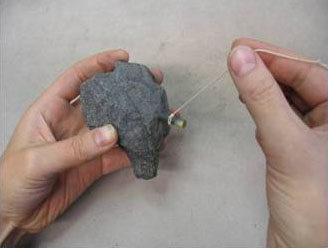An amateur geologists does not need expensive equipment to search and find samples. The basic equipment they need is just a rock hammer for breaking rocks and a pair of safety glasses to protect against the chips that fly off while breaking the rocks. Unglazed porcelain (a ceramic fuse, for example) can be used to find out the colour of a mineral’s streak. A steel spike or a common steel nail can be used to determine the hardness of a mineral. Magnetism can be determined with a magnet or a compass. While trekking in the woods, it is advisable to always have a compass or a GPS device with you. They also make saving the sample locations and marking them in the terrain easier.
Plan your searching trips well in advance. In addition to a basic map, it is useful to find some geological maps of the planned search area as well. These can be found at GTK’s Hakku service, for example. The best places to search are areas where felling, drainage or road construction work has been done recently – or any other work that requires digging into the soil – since these areas tend to have plenty of exposed rocks and bedrock. While planning your routes, keep in mind proper forest etiquette and avoid areas near people’s houses and yards. Taking samples on a small scale is allowed under the Finnish mining legislation. It is polite to inform the landowner of the area you plan to search samples in and, if necessary, ask for their permission to collect the samples.
GTK annually rewards the hobbyists who send the best samples. Local ore finding competitions are also organised, with their own rules and prizes. You can participate in these competitions by delivering ore, construction stone, industrial mineral or gemstone samples.
Delivering a sample means you have a chance to win.

A magnet can be used to identify magnetic minerals, such as magnetite and pyrrhotite.

The colour of a mineral’s streak can be determined by scratching the sample with a steel spike or making a streak on an unglazed porcelain surface (e.g. a ceramic fuse) with the sample. Photo Jari Nenonen, GTK.

The hardness of minerals varies. Hardness can be determined with an ordinary nail, for example.

Find out more about the tools used in amateur geology and learn to identify rocks and minerals with the Kivikone provided by Metso (in Finnish): http://kivikone.fi/
Useful links relating to geology:
- The Retkeilijän kiviopas guide (in Finnish) is aimed at everyone interested in rocks, minerals and searching for ores out in the wilderness. Retkeilijän kiviopas guide (in Finnish) e-book: http://weppi.gtk.fi/kiviopas/
- The Geolöytäjä magazine (in Finnish) is a news magazine for rock hobbyists with two issues each year: https://kivinayte.gtk.fi/geoloytaja-uutislehti/
- More information on the Finnish Mining Act (621/2011): https://www.finlex.fi/en/.
- The Geologia.fi portal offers multifaceted information on geology (in Finnish): http://www.geologia.fi/
- A virtual geological exhibition (in Finnish): http://spinelli.gtk.fi/
- In the Hakku service, you can search for and use different types of geological data products: https://hakku.gtk.fi/en/
- GTK’s library website features a library catalogue, online resources, guidance for finding the information you are looking for and an archive, among other things: https://gtk.verkkokirjasto.fi/web/arena/welcome
- The Gemstones of Finland e-book: http://tupa.gtk.fi/julkaisu/erikoisjulkaisu/ej_098.pdf
- Suomen Mineraalit (The Minerals of Finland, in Finnish) e-book: http://tupa.gtk.fi/julkaisu/erikoisjulkaisu/ej_031.pdf
- Suomen Kallioperä (Bedrock of Finland, in Finnish) book: http://www.geologinenseura.fi/suomenkalliopera/
- Geological outdoor maps: http://www.gtk.fi/geologia/retkeily/retkeilykartat/
